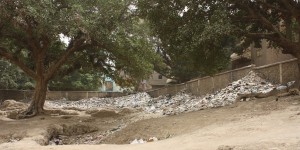
(Photo by Monica Hanna)
Egypt is known worldwide for its rich ancient heritage, but during the past year the lack of security has threatened the survival of many sites and led to extensive looting and destruction. In this article we review some of the monuments and archaeological sites that were affected by the worsening circumstances of security and neglect in Egypt.
In July 2012, the theft of 54 artefacts from the Egyptian Museum was reported along with the destruction of other sites such as the Fostat area, prompting the EU and UNESCO to start an initiative to safeguard the “intangible” culture of the Mediterranean.
In September 2012, tour guides organised a protest to demand the return of security. In addition, an in-focus article on the Egyptian Museum showed that it was suffering from decreased foreign tourism due to the country’s unrest, but a slight increase in Egyptian visitors.
Despite problems with security, the Khafre pyramid was reopened for visitors in October 2012 after the renovation of walkways leading to the tombs, the ventilation and electricity systems; in the hopes of boosting declining tourism numbers.
In November 2012, the Kumi Dome in Darb Al-Ahmar suffered from neglect when the fence surrounding it came down and people started to dump garbage around it. In December 2012, a renovation project concerning Djoser’s Pyramid came under scrutiny for the use of the improper materials and a lack of supervision from the Ministry of Antiquities.
In January 2013, the house of Ispenian in Haram was extensively looted and the structure itself suffered some destruction. In February 2013, in Luxor, statues of Amenhotep III underwent restoration.
In March 2013, bazaar owners in Luxor staged a protest after being threatened with dismissal if they were unable to pay rent. The protest completely closed off Luxor’s road leading to the West Bank, blocking access to Hatshepsut Temple, the Valley of the Kings among other sites. In Cairo, the Ministry of Antiquities launched a project to renovate Al-Muizz Street, after it suffered several lootings.
In April 2013, the Dahshur area witnessed illegal construction on ancient burial sites, prompting locals and archaeologists to protest the lack of security.
In May 2013, UNESCO threatened to declassify several heritage sites due to the lack of security and mismanagement of the sites.
In early June 2013, the American Embassy in Cairo issued a warning regarding the pyramids area in Cairo, warning US citizens from visiting the monuments due to the lack of security and “criminal conduct”. This prompted the Ministry of Antiquities to issue a statement regarding security of the monuments and later form a special committee to address the issue.
Archeologists have reported the dire situation of many sites including Abu Sir Al-Maleq, and Ancient Heliopolis which suffered lootings and destruction of the sites, culminating in a fire at the Temple of Ra in Ancient Heliopolis, which was reportedly ignited by “thugs”.
The tourism sector suffered a major blow when a member of Al-Jamaa Al-Islamiya Adel El-Khayat was appointed governor of Luxor, prompting tourism workers to organize a sit-in. El-Khayat later resigned.




